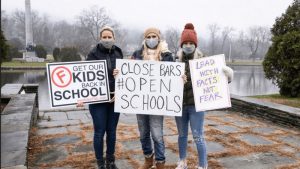The CDC’s long-awaited guidelines on a phased reopening for schools across the country issued Feb. 12 are still causing contention in many areas.
The recommendations for safe reopening were universal mask-wearing by students, teachers, and other staff, social distancing, priority vaccinations for teachers. However, vaccinations were not a prerequisite for opening schools—just an “additional layer of protection.” Other recommended measures include hand washing, disinfection of school facilities, diagnostic testing, and contact tracing to separate infected people.
The guidance also cautions schools about reopening if there is a high transmission of the virus in the surrounding community via color-coded community maps. Specifically, the CDC orders rates of community transmission into color-coded zones with recommendations for how schools should reopen depending on what zone they fall into. For schools in communities with low transmission, the blue zone, and for schools in communities with moderate transmission, the yellow zone, the CDC recommends reopening fully for in-person learning. For schools in communities with substantial transmission, the orange zone, the CDC recommends reopening with a hybrid model. For schools in communities with high transmission, the red zone, the CDC recommends elementary schools reopen with a hybrid model, but middle and high schools should be virtual. Consequently, the percentage of areas the CDC says middle and high schools should be fully virtual currently makes up over ninety percent of all U.S. counties, unless they can “strictly implement all mitigation strategies” or set up routine screening testing.
 Reported cases screenshot, CDC
Reported cases screenshot, CDC
Taking sides
The recommendations pitted school experts promoting the safety of returning to schools against teachers' unions who are pushing back against returning to in-person learning and left the Biden administration facing questions about the risk of widening gaps in educational attainment if millions of kids are kept out of school.
 In response to criticism from experts about basing school reopening recommendations on the level of spread in the surrounding community, CDC spokesperson Benjamin Haynes pointed out that the guidance notes that schools in high-transmission areas, or “red” areas, can still open if they are “strictly” following precautions. “At all levels of community transmission, the strategy provides options for in-person instruction,” he said. “Our recommendation is that schools in red areas can, in fact, provide in-person instruction, as long as they are strictly implementing mitigation and monitoring cases in the school community.”
In response to criticism from experts about basing school reopening recommendations on the level of spread in the surrounding community, CDC spokesperson Benjamin Haynes pointed out that the guidance notes that schools in high-transmission areas, or “red” areas, can still open if they are “strictly” following precautions. “At all levels of community transmission, the strategy provides options for in-person instruction,” he said. “Our recommendation is that schools in red areas can, in fact, provide in-person instruction, as long as they are strictly implementing mitigation and monitoring cases in the school community.”
Meanwhile, given the President’s goal of reopening the majority of elementary and middle schools for in-person learning during the first 100 days of his administration, the Biden administration responded by clarifying that it considers a school open if it offers students in-person instruction at least one day a week. This is a far lower threshold than his original aim suggested. Hence, Republicans called him out on moving the goalposts and putting teachers’ union demands in front of students' actual academic, social, and emotional needs.
Politically stumping for Biden’s relief bill
 AFT President Randi Weingarten
AFT President Randi Weingarten
In addition, both the American Federation of Teachers President Randi Weingarten and White House Covid–19 adviser, Dr. Anthony Fauci, have publicly made a case for Biden's $1.9 trillion relief package to start the safe reopening of schools, arguing that schools “need more resources” to re-open safely. Fauci said re-opening schools “can be done,” but school districts “really do need more resources. That's the reason why the national relief act that we're talking about getting passed—we need that.” The bill includes $130 billion in school funding to help schools upgrade buildings and buy protective gear. Teachers' unions concurred, saying many schools still have outdated ventilation systems and lack the kind of testing programs suggested by the CDC. The American Federation of Teachers added that “securing the funding to get this done” is necessary to make the CDC’s “guidance real.” Democrats on the House Education and Labor Committee advocated that schools need the money to repair buildings, buy protective equipment, and meet CDC standards.
In opposition, Republicans pointed out that Congress already approved $82 billion for schools in December’s relief package. While experts, like Monica Gandhi, from the Infectious Diseases Department at the University of California-San Francisco, said that the most important precautions, like masking and distancing, “are really cheap.” She continued to say that improving ventilation is the only area where there is a question about sufficient funding. Still, in many cases, the solution is as simple as opening a window instead of installing expensive ventilation systems. Gandhi further highlighted a CDC study from January, in its Morbidity and Mortality Weekly Report (MMWR), which found lower levels of virus in schools than in the community in Wisconsin, and just seven cases of in-school transmission among seventeen K-12 schools over several weeks last fall when mask-wearing rates were high.
Guidelines from federal departments like the CDC have an important role, but the decision to reopen schools is ultimately made at the local level. A decision that will also be swayed by the prevalent local circumstances and the influence of unions or which political party holds the most power at that level.


